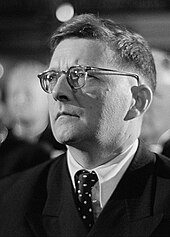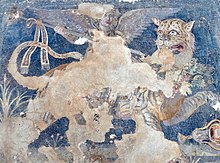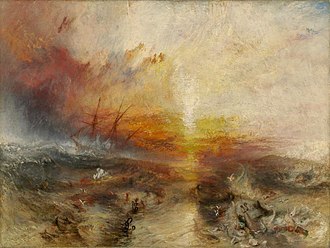Portal:History
The History Portal

History by Frederick Dielman
History (derived from Ancient Greek ἱστορία (historía) 'inquiry; knowledge acquired by investigation') is the systematic study and documentation of the human past. History is an academic discipline which uses a narrative to describe, examine, question, and analyze past events, and investigate their patterns of cause and effect. Historians debate which narrative best explains an event, as well as the significance of different causes and effects. Historians debate the nature of history as an end in itself, and its usefulness in giving perspective on the problems of the present.
The period of events before the invention of writing systems is considered prehistory. "History" is an umbrella term comprising past events as well as the memory, discovery, collection, organization, presentation, and interpretation of these events. Historians seek knowledge of the past using historical sources such as written documents, oral accounts or traditional oral histories, art and material artifacts, and ecological markers.
Stories common to a particular culture, but not supported by external sources (such as the tales surrounding King Arthur), are usually classified as cultural heritage or legends. History differs from myth in that it is supported by verifiable evidence. However, ancient cultural influences have helped create variant interpretations of the nature of history, which have evolved over the centuries and continue to change today. The modern study of history is wide-ranging, and includes the study of specific regions and certain topical or thematic elements of historical investigation. History is taught as a part of primary and secondary education, and the academic study of history is a major discipline in universities.
Herodotus, a 5th-century BCE Greek historian, is often considered the "father of history", as one of the first historians in the Western tradition, though he has been criticized as the "father of lies". Along with his contemporary Thucydides, he helped form the foundations for the modern study of past events and societies. Their works continue to be read today, and the gap between the culture-focused Herodotus and the military-focused Thucydides remains a point of contention or approach in modern historical writing. In East Asia a state chronicle, the Spring and Autumn Annals, was reputed to date from as early as 722 BCE, though only 2nd-century BCE texts have survived. The title "father of history" has also been attributed, in their respective societies, to Sima Qian, Ibn Khaldun, and Kenneth Dike. (Full article...)
David Gallaher (30 October 1873 – 4 October 1917) was an Irish-born New Zealand rugby union footballer best remembered as the captain of the "Original All Blacks"—the 1905–06 New Zealand national team, the first representative New Zealand side to tour the British Isles. Under Gallaher's leadership the Originals won 34 out of 35 matches over the course of tour, including legs in France and North America; the New Zealanders scored 976 points and conceded only 59. Before returning home he co-wrote the classic rugby text The Complete Rugby Footballer with his vice-captain Billy Stead. Gallaher retired as a player after the 1905–06 tour and took up coaching and selecting; he was a selector for both Auckland and New Zealand for most of the following decade.
Born in Ramelton, Ireland, Gallaher migrated to New Zealand with his family as a small child. After moving to Auckland, in 1895 he joined Ponsonby RFC and was selected for his province in 1896. In 1901–02 he served with the New Zealand Contingent in the Anglo–Boer War. He first appeared on the New Zealand national team for their unbeaten tour of Australia in 1903, and played in New Zealand's first ever Test match, against Australia in Sydney. The Originals Gallaher captained during 1905–06 helped to cement rugby as New Zealand's national sport, but he was relentlessly pilloried by the British press for his role as wing-forward. The use of a wing-forward, which critics felt was a tactic to deliberately obstruct opponents, contributed to decades of strain between the rugby authorities of New Zealand and the Home Nations; the International Rugby Football Board (IRFB) effectively outlawed the position in 1931. (Full article...)
HMS Calliope was a Calypso-class corvette (later classified as a third-class cruiser) of the Royal Navy of the United Kingdom which served from 1887 until 1951. Exemplifying the transitional nature of the late Victorian navy, Calliope was a sailing corvette—the last such ship built for the Royal Navy—but supplemented the full sail rig with a powerful engine. Steel was used for the hull, and like the earlier iron-hulled corvettes, Calliope was cased with timber and coppered below the waterline, in the same manner as wooden ships.
Calliope was known for "one of the most famous episodes of seamanship in the 19th century", when the vessel was the only ship present to avoid being sunk or stranded in the tropical cyclone that struck Apia, Samoa in 1889. After retirement from active service, Calliope served as a training ship until 1951, when it was sold for breaking. (Full article...)
Genghis Khan (born Temüjin; c. 1162 – August 1227), also known as Chinggis Khan, was the founder and first khan of the Mongol Empire. After spending most of his life uniting the Mongol tribes, he launched a series of military campaigns, conquering large parts of China and Central Asia.
Born between 1155 and 1167 and given the name Temüjin, he was the eldest child of Yesugei, a Mongol chieftain of the Borjigin clan, and his wife Hö'elün. When Temüjin was eight, his father died and his family was abandoned by its tribe. Reduced to near-poverty, Temüjin killed his older half-brother to secure his familial position. His charismatic personality helped to attract his first followers and to form alliances with two prominent steppe leaders named Jamukha and Toghrul; they worked together to retrieve Temüjin's newlywed wife Börte, who had been kidnapped by raiders. As his reputation grew, his relationship with Jamukha deteriorated into open warfare. Temüjin was badly defeated in c. 1187, and may have spent the following years as a subject of the Jin dynasty; upon reemerging in 1196, he swiftly began gaining power. Toghrul came to view Temüjin as a threat and launched a surprise attack on him in 1203. Temüjin retreated, then regrouped and overpowered Toghrul; after defeating the Naiman tribe and executing Jamukha, he was left as the sole ruler on the Mongolian steppe. (Full article...)
Air Vice Marshal Francis Hubert (Frank) McNamara, VC, CB, CBE (4 April 1894 – 2 November 1961) was an Australian recipient of the Victoria Cross, the highest decoration for valour in the face of the enemy that can be awarded to a member of the British and Commonwealth forces. Serving with the Australian Flying Corps, he was honoured for his actions on 20 March 1917, when he rescued a fellow pilot who had been forced down behind enemy lines. McNamara was the first Australian aviator—and the only one in World War I—to receive the Victoria Cross. He later became a senior commander in the Royal Australian Air Force (RAAF).
Born and educated in Victoria, McNamara was a teacher when he joined the militia prior to World War I. In 1915, he was selected for pilot training at Central Flying School, Point Cook, and transferred to the Australian Flying Corps the following year. He was based in the Middle Eastern Theatre with No. 1 Squadron when he earned the Victoria Cross. In 1921, McNamara enlisted as a flying officer in the newly formed RAAF, rising to the rank of air vice marshal by 1942. He held senior posts in England and Aden during World War II. Retiring from the Air Force in 1946, McNamara continued to live in Britain until his death from heart failure in 1961. (Full article...)

Dmitri Shostakovich's Symphony No. 7 had its Leningrad première on 9 August 1942 during the Second World War, while the city was under siege by the Nazi German forces.
Shostakovich had intended the piece to be premièred by the Leningrad Philharmonic Orchestra, but because of the siege that group was evacuated from the city, as was the composer himself. The world première of the symphony was held on 5 March 1942, in Kuybyshev with the Bolshoi Theatre Orchestra. The Leningrad première was performed by the surviving musicians of the Leningrad Radio Orchestra, supplemented with military performers, with Karl Eliasberg conducting. Most of the musicians were suffering from starvation, which made rehearsing difficult: musicians frequently collapsed during rehearsals, and three died. The orchestra was able to play the symphony all the way through only once before the concert. (Full article...)

The mosaics of Delos are a significant body of ancient Greek mosaic art. Most of the surviving mosaics from Delos, Greece, an island in the Cyclades, date to the last half of the 2nd century BC and early 1st century BC, during the Hellenistic period and beginning of the Roman period of Greece. Hellenistic mosaics were no longer produced after roughly 69 BC, due to warfare with the Kingdom of Pontus and the subsequently abrupt decline of the island's population and position as a major trading center. Among Hellenistic Greek archaeological sites, Delos contains one of the highest concentrations of surviving mosaic artworks. Approximately half of all surviving tessellated Greek mosaics from the Hellenistic period come from Delos.
The paved walkways of Delos range from simple pebble or chip-pavement constructions to elaborate mosaic floors composed of tesserae. Most motifs contain simple geometric patterns, while only a handful utilize the opus tessellatum and opus vermiculatum techniques to create lucid, naturalistic, and richly colored scenes and figures. Mosaics have been found in places of worship, public buildings, and private homes, the latter usually containing either an irregular-shaped floor plan or peristyle central courtyard. (Full article...)

The Zong massacre was a mass killing of more than 130 enslaved African people by the crew of the British slave ship Zong on and in the days following 29 November 1781. The William Gregson slave-trading syndicate, based in Liverpool, owned the ship as part of the Atlantic slave trade. As was common business practice, they had taken out insurance on the lives of the enslaved Africans as cargo. According to the crew, when the ship ran low on drinking water following navigational mistakes, the crew threw enslaved Africans overboard.
After the slaver ship reached port at Black River, Jamaica, Zong's owners made a claim to their insurers for the loss of the enslaved Africans. When the insurers refused to pay, the resulting court cases (Gregson v Gilbert (1783) 3 Doug. KB 232) held that in some circumstances, the murder of enslaved Africans was legal and that insurers could be required to pay for those who had died. The jury found for the slavers but at a subsequent appeal hearing the judges, led by Lord Chief Justice, the Earl of Mansfield, ruled against the slave-trading syndicate owners, on the grounds that new evidence suggested that the captain and crew were at fault. (Full article...)
The Xá Lợi Pagoda raids (Vietnamese pronunciation: [saː˦˥ ləːj˨˩˨] SAW-LIE) were a series of synchronized attacks on various Buddhist pagodas in the major cities of South Vietnam shortly after midnight on 21 August 1963. The raids were executed by the Army of the Republic of Vietnam Special Forces under Colonel Lê Quang Tung, and combat police, both of which took their orders directly from Ngô Đình Nhu, younger brother of the Roman Catholic President Ngô Đình Diệm. Xá Lợi Pagoda, the largest pagoda in the South Vietnamese capital, Saigon, was the most prominent of the raided temples. Over 1,400 Buddhists were arrested, and estimates of the death toll and missing ranged up to the hundreds. In response to the Huế Vesak shootings and a ban on the Buddhist flag in early May, South Vietnam's Buddhist majority rose in widespread civil disobedience and protest against the religious bias and discrimination of the Catholic-dominated Diệm government. Buddhist temples in major cities, most prominently the Xá Lợi pagoda, became focal points for protesters and assembly points for Buddhist monks from rural areas.
In August, several Army of the Republic of Vietnam (ARVN) generals proposed the imposition of martial law, ostensibly to break up the demonstrations, but in reality to prepare for a military coup. Nhu, already looking to arrest Buddhist leaders and crush the protest movement, used the opportunity to preempt the generals and embarrass them. He disguised Tung's Special Forces in army uniforms and used them to attack the Buddhists, thereby causing the general public and South Vietnam's U.S. allies to blame the army, diminishing the generals' reputations and ability to act as future national leaders. (Full article...)
After Yazid died during the civil war, Zufar supported Abd Allah ibn al-Zubayr's bid to wrest the caliphate from the Umayyads, expelling the Umayyad governor of Qinnasrin, and dispatching Qaysi troops to back the pro-Zubayrid governor of Damascus, al-Dahhak ibn Qays al-Fihri. At the 684 Battle of Marj Rahit, the Qays were crushed by the Umayyads and their tribal allies from the Banu Kalb, rivals of the Qays, and al-Dahhak was slain. Afterward, Zufar set up headquarters in the Jaziran town of Qarqisiya (Circesium) and led the Qays against the Kalb, launching several raids against the latter in the Syrian Desert. By 688–689, he became embroiled in a conflict with the Taghlib tribe in support of his Qaysi ally Umayr ibn al-Hubab of the Banu Sulaym, despite previous efforts to mend their feud. After resisting three sieges of Qarqisiya from 685 to 691, Zufar negotiated a peace with the Umayyad caliph Abd al-Malik (r. 685–705). Zufar abandoned Ibn al-Zubayr's cause in return for privileges in the Umayyad court and army, as well as pardons and cash for his Qaysi partisans, who were integrated into the Umayyad military. The peace was sealed by the marriage of Zufar's daughter Rabab to the caliph's son Maslama. (Full article...)
Antiochus XII Dionysus Epiphanes Philopator Callinicus (Ancient Greek: Ἀντίοχος Διόνυσος Ἐπιφανής Φιλοπάτωρ Καλλίνικος; between 124 and 109 BC – 82 BC) was a Hellenistic Seleucid monarch who reigned as King of Syria between 87 and 82 BC. The youngest son of Antiochus VIII and, most likely, his Egyptian wife Tryphaena, Antiochus XII lived during a period of civil war between his father and his uncle Antiochus IX, which ended with the assassination of Antiochus VIII in 96 BC. Antiochus XII's four brothers laid claim to the throne, eliminated Antiochus IX as a claimant, and waged war against his heir Antiochus X.
By 87 BC, only two claimants remained, both brothers of Antiochus XII: Demetrius III and Philip I. The realm of Demetrius III was initially centered in Damascus but later extended over most of Syria. Demetrius III was defeated by Philip I and went into exile in Parthia, allowing Antiochus XII to gain control of Damascus while Philip I remained in the Syrian capital Antioch. Antiochus XII consolidated his territory within inner Syria and did not seek to expand into the territories of Philip I, who attempted to annex Damascus but was repulsed. Antiochus XII focused his attention on Syria's southern reaches into which the Judaeans and Nabataeans sought to expand. (Full article...)






![Image 4 Apollo 11 Photograph credit: Neil Armstrong Apollo 11 was the fifth crewed mission of NASA's Apollo program. After launching from the Kennedy Space Center in Florida on July 16, 1969, commander Neil Armstrong and Apollo Lunar Module pilot Buzz Aldrin landed Eagle in Mare Tranquillitatis on July 20, at 20:17:40 UTC, while command module pilot Michael Collins remained on Columbia in lunar orbit. Armstrong was the first to exit the spacecraft, stepping onto the surface 6 hours and 39 minutes later, on July 21, at 02:56:15 UTC; nineteen minutes later, Aldrin joined him on extravehicular activity, which lasted 2 hours, 31 minutes and 40 seconds. Armstrong and Aldrin lifted off from Tranquility Base after almost 22 hours on the lunar surface and rejoined Collins in the command module, before splashing down in the Pacific Ocean on July 24. The mission was planned to the minute, with the majority of the photographic tasks performed by Armstrong with a single Hasselblad camera. Most of the photographs taken on the Moon that include an astronaut are of Aldrin; there are only five images of Armstrong partly shown or reflected, as in this photograph, with Armstrong and the lunar module reflected in Aldrin's helmet visor. "As the sequence of lunar operations evolved," Aldrin explained, "Neil had the camera most of the time [...] It wasn't until we were back on Earth and in the Lunar Receiving Laboratory looking over the pictures that we realized there were few pictures of Neil." More featured pictures](http://upload.wikimedia.org/wikipedia/commons/thumb/9/98/Aldrin_Apollo_11_original.jpg/119px-Aldrin_Apollo_11_original.jpg)







































